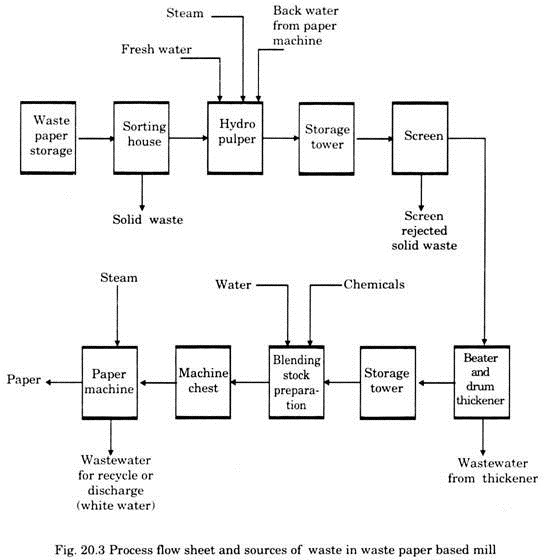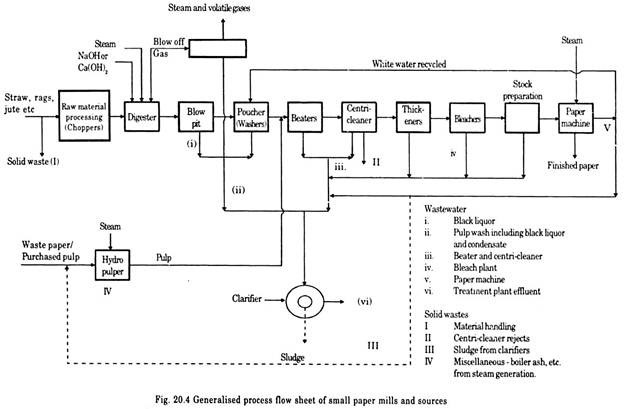How to Manufacture Paper: Pulping Processes, Paper Making and Flow Sheet!
Pulping Processes for Manufacturing Paper:
The main pulping processes that are normally employed in paper industry include:
(i) Chemical process
(ii) Chemo-mechanical process
(iii) Mechanical process (hydro-pulping)
(i) Chemical Process:
This involves digestion of raw material like agricultural residues, gunny, jute, etc., at high temperature and pressure in the presence of chemicals like sodium hydroxide and/or lime.
Specially designed spherical digesters with capacity around 25 cu m are employed for this purpose. The rotary digester provides necessary mixing and efficient heating of the raw material. Steam is used for heating.
Steam pressure is maintained between 5 and 6 kg/cm2. The temperature of the digesting material will be around 150°C. About 1.2-1.5 tonne of steam are required for each tonne of raw material digested.
Chemicals are added in solution along with raw material prior to cooking. Digestion time of 2.5 to 5 hours is provided for proper cooking. A ratio of raw material to water of 1 to 3.3-4.0 is maintained before digestion starts. Two processes are used.
They are:
(a) Kraft or Sulphate Process:
The cellulosic materials after chipping to proper size are cooked in caustic soda, sodium sulphide mixture under temperature and pressure. This process dissolves the fibre binding materials such as the lignins and loosens the cellulosic fibres. The spent liquor, known as black liquor, is recovered for chemicals and the pulp is washed and bleached before it is made into paper.
(b) Sulphite Process:
In the sulphite process the cooker liquor consists of calcium or magnesium bisulphite and sulphurous acid. Where calcium salt is used the spent cooker liquor is not utilised for recovery of chemicals.
(ii) Chemo-Mechanical Pulping:
As the name suggests, the process makes use of both chemical and mechanical processes in series. The raw material is soaked in 3-5% caustic soda solution at 90°C for 15 to 30 minutes. Acid sulphites are also employed as pulping chemical in a few cases. The soaked material is then subjected to drastic mechanical treatment to separate fibres.
(iii) Mechanical Process:
For waste paper and recycled paper, hydro-pulping is adopted. Hydro-pulping unit comprises of a high speed rotating disc which chops the paper to fibre in presence of steam and moisture. The pulp yield is estimated to be 70-80%. Size of the hydro-pulper varies with the plant size.
Pulp Processing:
(i) Pulp Washing:
Chemically digested pulp is discharged into a blow pit or on a perforated floor where pan of the black liquor (BL) also known as spent liquor drains out. In some mills the cooked materials is directly taken for washing in pouchers where washing is done by vacuum rotary drum.
The washing continues for 2-3 hours and is in series if more than one poucher is used. The pulp wash is one of the major sources of wastewater besides black liquor. The drained out black liquor joins the pulp wash water before leaving the unit. The wastewater leaving this section is very strong initially and weak in final stages of washing.
(ii) Beater, Centri-Cleaner, Thickener:
Pulp from poucher is dumped to beater either directly or through storing chest depending on the operation schedule. Pulp is beaten to separate fibres and remove adhering dirt, chemicals and colour. Some mills employ washing along with beating thus creating a source of wastewater.
From beater, the pulp is screened and then taken to centri-cleaner for removal of heavy inorganic particles (mostly sand). It is then pumped to thickener where water is sucked by rotary drums and discharged as wastewater. The pulp in this section still contains some colour but can be used to make boards and unbleached paper.
(iii) Bleaching:
The process is adopted in mills where bleached paper is produced. After thickening, the pulp is subjected to chlorination. Chlorine requirement is reported to be 120 kg/day, in a 2,000 TPA plant but it generally varies with the type of raw material used.
If straw is the major raw material, the chlorine requirement will be high. After chlorination, the pulp is subjected to alkali extraction, only under special circumstances, popularly known as caustic extraction.
This is followed by calcium hypochlorite treatment. Hypochlorite required is about half the quantity of chlorine. The pulp is white and the yield is about 30-35% of raw material used.
These three steps together contribute bleach plant wastewater. In small mills, only calcium hypochlorite or bleaching powder is used and the conventional steps are not usually followed.
Paper Making:
(i) Blending, Conditioning and Stock Preparation:
Blending provides required pulp to water ratio before sending it to the paper machine. Further conditioning by chemicals such as alum, rosin, talc and acid to suit the requirements of final paper quality and addition of dyes to make coloured paper are also adopted.
(ii) Paper Machine:
This consists of a moving wire mesh and rotary driers. Steam is used in driers to drive away moisture from the sheet of paper formed on the wire mesh and picked up by the driers. The wastewater generated in this section is known as white water and is recycled in the process to the extent of 80% for pulp washing in the poucher in most of the mills. Finished product is cut to size and ready for marketing.
The moisture content of finished paper varies from 2-8% by weight with an average value of 4.5%.
The flow sheet of the processes involving straw, rag and waste paper are given in Figs. 20.1 to 20.3, respectively. A generalised flow sheet adopted for making paper in small mills depicting sources of wastes is given in Fig. 20.4.



